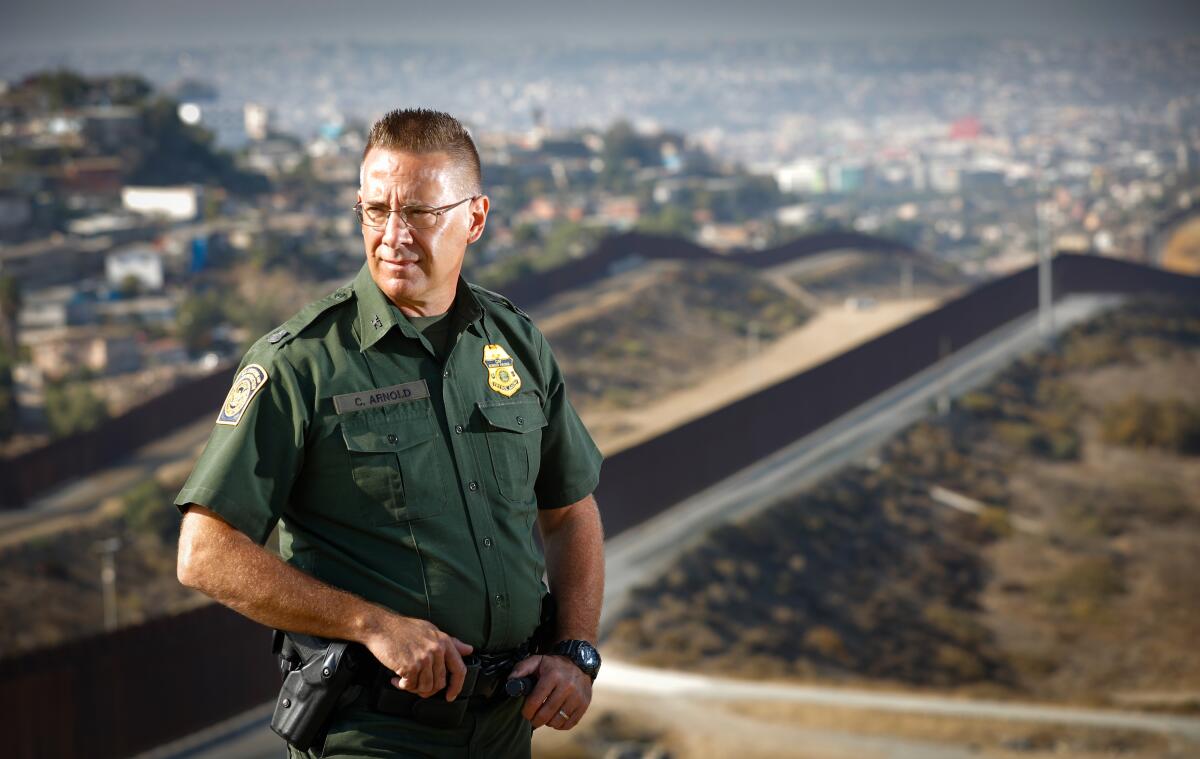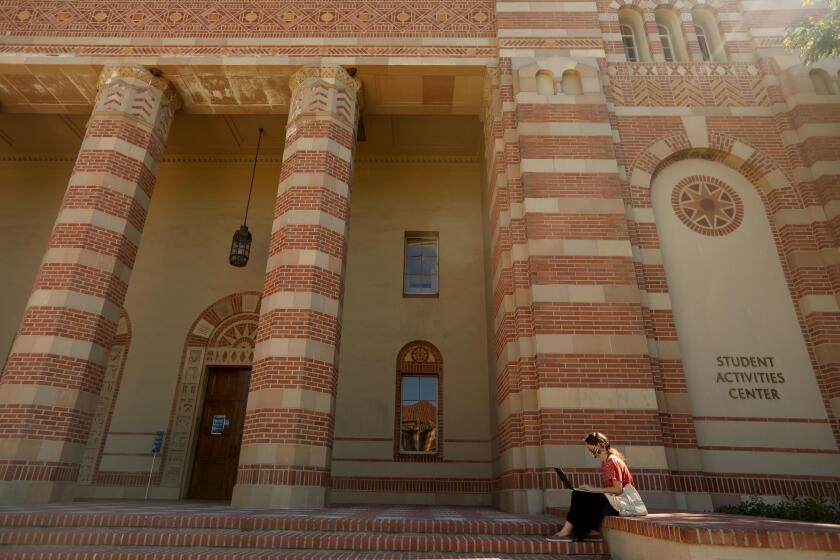In a lifetime on the border, Agent Chancy Arnold has seen it transform

- Share via
San Diego — Fresh out of the academy yet still very much an agent-in-training, Chancy Arnold was finally being given a little range.
He and his partner were told to drive on the border road east, familiarize themselves with the rolling hills and unmarked trails that would become their new office.
As they approached the base of Otay Mountain in San Diego County, they came upon a man lying face down in the dirt. About 50 yards to the south, a flimsy barbed wire fence denoted the U.S.-Mexico border.
Strange, Arnold thought, does he really think he’s hiding from us?
The agents yelled at the man: “Get up, we can see you!”
He remained still.
Closer inspection revealed the grisly truth: Someone had driven the migrant through the border, ordered him to the ground and put a bullet in the back of his head.
Even as a rookie, Arnold thought he had a pretty good idea of what it would be like to be a Border Patrol agent. His father had worn the same olive green uniform for as long as he could remember. But the discovery that day was a shock and a glimpse of the ruthless landscape he was now part of.
That was 1985, and Arnold is now nearing 35 years with the agency, making him the longest-serving Border Patrol agent in the nation.
The border has changed considerably in that time.
Arnold has watched the terrain transform into one of fences and roads, surveillance cameras and sensors. He’s seen migration patterns turn from single Mexican men to unaccompanied children and asylum-seeking families.
He’s had to acknowledge the humanity and desperation of the people he encounters while enforcing the laws and policies he’s sworn to uphold.
Most agents retire after 20 to 25 years. But Arnold always planned to work until the Border Patrol made him leave. That will be in July, when he turns 57.
“Since Day 1,” Arnold said, “I was going to work until the end.”
Introduced to the border at age 3
Arnold was just shy of 3 years old when his father left his job as a roughneck on a Montana oil rig and joined the Border Patrol in 1965. The Arnolds left the northern plains for the dusty borderlands of El Centro.
The year his father joined was a turning point on the southwestern border. The U.S. bracero program, which had sanctioned agricultural labor by Mexican migrants, had just been shut down. And the Immigration and Nationality Act of 1965 for the first time restricted legal immigration from the Western Hemisphere, including Mexico, while opening it up to Asia and Africa. Preference was given to those with U.S. citizen family members or desirable skills and professions.
But demand for Mexican labor didn’t end, and soon migration that once might have been legal was now illegal, creating a large new population of unauthorized immigrants.
The El Centro sector apprehended some 5,300 migrants in 1965, a figure that more than doubled over the next five years. In neighboring San Diego, apprehensions rose to 50,600 over the same period.
It wasn’t until Arnold was around 21 that he could imagine carving his own path as an agent.
“What the Border Patrol represented — securing our borders, securing our nation — appealed to me at the time,” he recalled. It also provided for a long-term career, no college degree needed, and the chance to work outdoors.
“Quite honestly,” he said, “it was what I knew.”
On a recent Friday, Arnold made the familiar trek to Arnie’s Point, a vista overlooking what used to be one of the most heavily trafficked illegal border crossings.
It looks nothing like it did when he was a mop-top rookie.
But gazing down, Arnold — with a military-style crew cut now turned silver — was looking decades into the past.
He could see thousands of migrants gathering in a soccer field that has since been filled in by dirt. He could see the vendors in the festival-like atmosphere selling last-minute provisions before the nightly surge north. And he could see agents running through the scrub brush in pursuit.
Catch who you can, process them at the station, come back for more. Repeat. That was the pace back in those days.
20 years later, he’s an agent
In 1985, San Diego accounted for more than 427,000 of the southwest border’s 1.2 million apprehensions, the most of any sector.
Just like when his father joined the agency, the southwestern border was at another turning point. In 1986, the Immigration Reform and Control Act sought to stem the rising illegal flow by authorizing a 50% increase in Border Patrol staffing and toughening criminal laws against employers. At the same time, it provided a pathway for amnesty for some longtime migrant residents, giving them a chance at legal status.
But illegal immigration continued to grow.
And the increased manpower was slow to materialize. It wasn’t until 1994 that the roughly 3,000 agents nationwide in the mid-1980s grew to 4,200, according to Syracuse University’s Transactional Records Access Clearinghouse, which gathers federal data.
About 140 of those agents were assigned to Brown Field station when Arnold began. Their coverage area stretched from just east of the San Ysidro Port of Entry to Otay Mountain.
It was from here that Arnold departed each evening, armed with a six-shooter revolver, six to 12 spare bullets, handcuffs and a radio. Agents patrolled in American-made SUVs.
The border fence then was nothing more than barbed wire or cable strung between poles. It didn’t stop foot traffic from coming north. Rather, it was meant to stop vehicle loads of drugs or people. It worked — sometimes.
“Working the swing shift, there’d be eight or nine vehicle chases going on at the same time,” Arnold recalled. “It’d be like a dog fight, trying to figure out who’s got this chase and what’s going on with that one.”
Just north of Arnie’s Point, finger canyons disappear around the bend. That’s where, in the dense brush, Arnold once hunted for bandits who were hunting for migrants.
The canyons were notoriously violent, a place where robbers could easily hide and prey on those who crossed north. Rapes, assaults and murder were common.
Arnold was just three years out of the academy when he was picked for the elite bandit detail. The stakes were higher on this assignment, and gunfights were practically inevitable.
In fact, Arnie’s Point was named for one. It’s where Agent Arnie Forsyth was once hit in the buttocks during a shoot-out with bandits.
Arnold got into his first and only gunfight in a canyon farther west.
Shootout on the bandit detail
The detail had intelligence of a two-man ambush operation, where one bandit would hide behind a stand of trees at a T-intersection of two trails while the other would distract passing migrants.
Sure enough, Arnold’s group approached and took down the distractor. Then the bandit’s partner came around from behind with a loaded .45-caliber pistol. The agents fired. The bandit was hit; he survived.
Arnold’s rotation on the bandit detail was the second to last before the unit was disbanded. But he credits the experience for making him a better cop.
“I think it helped me grow up.”
More substantial fencing starting going up around 1990 to stem the increasing flow of migrants. But the corrugated landing-mat material, installed on its side, acted more like a ladder than a fence.
It was also easily breached with tools.
At the same time, a wave of anti-immigrant sentiment was sweeping the state. Then-Gov. Pete Wilson helped push through Proposition 187, a voter-approved initiative that slashed state services such as healthcare and public education to unauthorized immigrants. The law was later overturned by a federal judge.
A new strategy was launched in 1994 called Operation Gatekeeper that flooded the San Diego border with agents in three tiers — a highly visible show of force that would dissuade migrants from crossing in the first place and catch those who did farther inland.
Apprehensions soared in the first year to more than half A million, then they began to drop off sharply. From fiscal 1995 to 2005, overall apprehensions in the sector declined by 76%.
While some may have been disinclined to make the journey north, however, most just shifted routes east to the less fortified deserts, into the territory Arnold’s father had once patrolled.
In the five years after Gatekeeper was launched, apprehensions in El Centro’s sector rose from 37,317 to 238,126.
The shift didn’t come as a surprise but was rather a tactical decision by leaders: Push illegal crossings away from large cities and into wilderness areas for easier apprehensions. But the human cost was high, as the harsher environment claimed thousands of lives over the years.
Following in his father’s footsteps, Arnold eventually transitioned into management.
He’s covered just about every job in the San Diego sector: supervisor, training officer, watch commander. He spent 13 years in the prosecutions unit, readying cases for criminal and administrative court. By then, he had gone back to school, earning a criminal justice degree.
Arnold went to Washington in 2009 for nine months to coordinate care for unaccompanied minors, who in the years preceding had been fleeing to the United States in record numbers. The waves had sent authorities scrambling to find a way to place the children, mostly teens, in appropriate housing long term while caring for their short-term needs at Border Patrol stations.
The experience would help prepare him for his current role.
Change comes amid ‘crisis’
As assistant chief over prosecutions, asset forfeiture and detentions in the San Diego sector, Arnold has most recently been in charge of mitigating what he calls a “humanitarian crisis” that started about a year ago with the surge of Central American caravans arriving at the border to seek asylum. Most of them are families.
Although some of the migrants follow protocol and present themselves at ports of entry, many see the long wait of metered lines and cross illegally. Then they sit and wait to be arrested, so they can claim asylum.
Many families ended up staying several days at Border Patrol stations, long past the 72-hour limit, as Immigration and Customs Enforcement — reluctant to release them into the community — determined where to house them next in accordance with a court agreement that set out the terms of detention for children.
“All our Border Patrol stations are set up, built and designed not for families, not for children, but for single adult males,” Arnold said. “We were holding people in custody longer than we ever intended to hold people in. People in custody longer require more resources.”
The change in population shifted agents away from patrolling the line and into caretaker roles.
The latest scrutiny comes as a group of doctors urges Customs and Border Protection, the umbrella agency of the Border Patrol, to hold free flu shot clinics in detention centers for migrant children. Three children have died in detention from the flu in the past year, none in San Diego.
A few weeks ago, doctors demonstrated outside the Border Patrol’s sector headquarters in Chula Vista, where Arnold is based; the day ended with six protesters arrested.
CBP officials have called vaccine programs in short-term detention “not feasible.”
The current spotlight on the border is perhaps the most intense it’s ever been and has created political and philosophical rifts across the country. In many ways, it illustrates the deeper divisions facing the nation.
Arnold tries not to let the discord get to him.
“I know there’s always throughout history going to be those individuals who don’t agree with who we are or what we do,” he said. “One thing I’ve tried to make sure we’re focused on is that we conduct ourselves with integrity and as professionals.”
The vast majority of agents are at the mercy of laws, policies and a vast bureaucracy operating high above them.
“We don’t get the luxury to say no to laws we’ve been asked to enforce,” he said. “We’re going to enforce those laws.”
But not at the expense of losing their humanity.
‘Your heart goes out’
“I think we’re portrayed as not caring about people,” Arnold said. “We do. Your heart goes out to these people. We are humans, we do care about the individuals we encounter.”
The Border Patrol is being handed over to a new generation, as agents who came on board during the hiring frenzy of Operation Gatekeeper begin to consider retirement.
But Arnold won’t be leaving without first getting a seventh star on the sleeve of his uniform. He gets one for every five years of service.
“I’ve never met someone with seven stars in my career,” he said.
Not even his dad, who retired with four.
Davis writes for the San Diego Union-Tribune
More to Read
Sign up for Essential California
The most important California stories and recommendations in your inbox every morning.
You may occasionally receive promotional content from the Los Angeles Times.










